Exemples de code en Python, C/C++, C#, Java, etc. pour les capteurs Dracal en mode COM/série (VCP)
[Dernière mise à jour: 14/03/2024]

Introduction
Il est possible de se procurer la majorité des capteurs USB Dracal munis de l'option VCP. Cette option permet à l'utilisateur de choisir le protocole de communication utilisé par l'instrument pour communiquer ses données. Les instruments munis de cette option sont identifiables par la présence du préfixe "VCP-" (au lieu de "USB-") dans leur code de produit. L'utilisation du protocole VCP permet l'intégration des données sans passer par l'intermédiare d'un logiciel tiers tel que notre outil en ligne de commande dracal-usb-get par exemple. Suivez ce lien pour un survol des outils d'intégration disponibles pour vos produits Dracal.
L'objectif de cette page est d'illustrer par des exemples concrets comment intégrer les données de vos instruments communiquant en mode VCP dans différents langages et environnements.
1. Prérequis
1. Avoir en sa possession un instrument muni de l'option VCP
Ces instruments sont identifiables par le préfixe "VCP-" présent dans leur nom de produit.
2. Avoir une connaissances élémentaires d'utilisation de la ligne de commande
Pourquoi? Parce que tous les instruments Dracal sont livrés en mode USB et que le passage entre les modes USB et VCP se fait via les outils en ligne de commande. Suivez ce lien si vous cherchez où trouver les outils en ligne de commande.
3. Avoir pris connaissance du guide d'utilisation des produits VCP
Si ce n'est déjà fait, voici le lien vers le guide d'utilisation des produits VCP.
La présente documentation considère également que vous avez réussi avec succès à basculer votre instrument du mode USB vers le mode VCP et que vous avez réussi communiquer avec votre instrument. Si tel n'est pas le cas, il est recommandé de consulter le tutoriel Démarrer avec le mode VCP avant de poursuivre votre lecture.
2. Exemples dans différents langages de programmation
 2.1. Python
2.1. Python
Dépôt GitHub contenant un exemple de code Python prêt à l'emploi
Voici un exemple d'utilisation des capteurs Dracal en utilisant uniquement les bibliothèques Python. Il appose un horodatage devant chaque ligne de données et les enregistre dans un fichier. Une validation de l'intégrité des données est également effectuée. Bibliothèques utilisées :
- Le module "serial" nous permet d'interagir avec le dispositif via le protocole VCP.
- Le module "crccheck" permet de vérifier l'intégrité des données reçues.
Note Les deux bibliothèques sont listées sur pypi.org et peuvent être installées à l'aide de pip (e.g. pip install pyserial).
import sys
import time
import serial # https://pypi.org/project/pyserial/
import crccheck # https://pypi.org/project/crccheck/
# Parse command-line arguments
if len(sys.argv) not in (2, 3):
print("Syntax: %s [poll_interval_ms]" % sys.argv[0])
print("Example (Windows) %s COM1 1000" % sys.argv[0])
print("Example (Linux/MacOS) %s /dev/ttyACM0 1000" % sys.argv[0])
sys.exit(1)
port = sys.argv[1]
if len(sys.argv) >= 3:
interval = int(sys.argv[2])
else:
interval = 1000 # default
crc_checker = crccheck.crc.CrcXmodem()
# Open serial port
with serial.Serial(port) as ser:
ser.readlines(2) # Discard the first two lines as they may be partial
ser.write(b"INFO\n") # Get the info line
time.sleep(0.3) # Allow 100 ms for request to complete
ser.write(b"POLL %d\n" % interval) # Set poll interval
time.sleep(0.3)
ser.write(b"FRAC 2\n") # Return data with two digits past the decimal
# Process all lines in a loop
while True:
line = ser.readline()
t = time.ctime()
if not line:
break
# Check data integrity using CRC-16-CCITT (XMODEM)
try:
data, crc = line.split(b"*")
crc = int(crc, 16) # parse hexadecimal string into an integer variable
crc_checker.process(data)
computed_crc = crc_checker.final()
crc_checker.reset()
crc_success = computed_crc == crc
except ValueError:
# We will get here if there isn't exactly one '*' character in the line.
# If that's the case, data is most certainly corrupt!
crc_success = False
if not crc_success:
print("Data integrity error")
break
# Decode bytes into a list of strings
data = data.decode("ASCII").strip(",").split(",")
if data[0] == "I":
if data[1] == "Product ID": # For the INFO command response
info_line = data
padlen = max(len(s) for s in info_line[4::2])
print(", ".join(info_line))
else: # Other info lines only need the message to be echoed
print(data[3])
else:
# Create an ID for the device
device = f"{data[1]} {data[2]}"
# Convert number strings to the appropriate numerical format
for i in range(4, len(data), 2):
try:
data[i] = int(data[i])
except ValueError:
data[i] = float(data[i])
# Convert data to a tuple of (sensor, value, unit) triads
data = zip(info_line[4::2], data[4::2], data[5::2])
# Display the current time, product id and serial number before every point
print(f"\n{t}, {device}")
for d in data:
print(("{:" + str(padlen + 2) + "}{} {}").format(*d))
générant la sortie suivante:
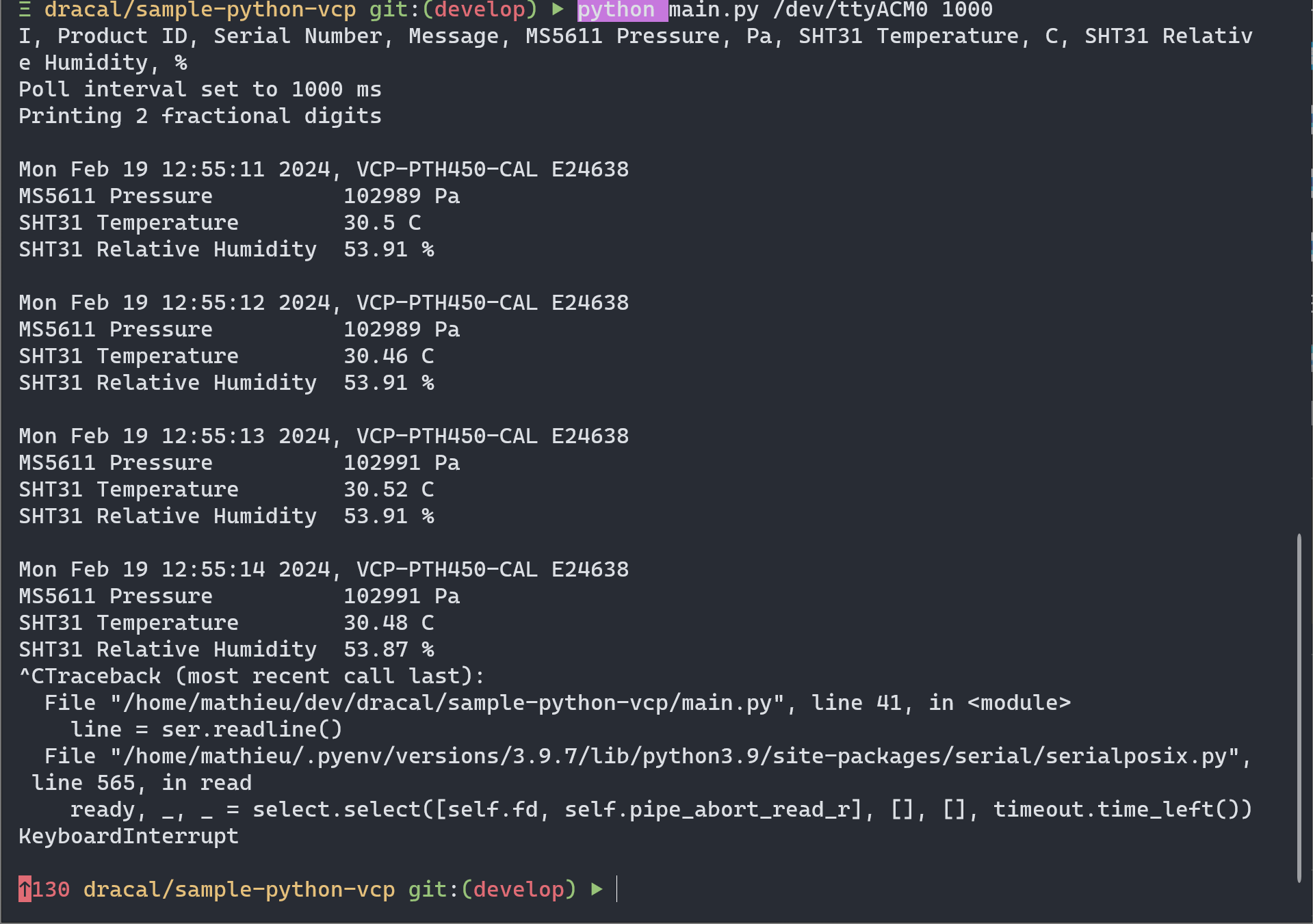
 2.2. C (POSIX)
2.2. C (POSIX)
Dépôt GitHub contenant un exemple de code C (posix) prêt à l'emploi
Cet exemple vous permet d'accéder aux données d'un capteur en mode VCP à l'aide du langage C (pour les systèmes d'exploitation de type *nix ; par exemple Unix/Linux). Vous trouverez des méthodes qui ouvrent une connexion, envoient, lisent et interprètent les données du dispositif.
Note: ce programme a été conçu pour fonctionner avec les capteurs de la série PTH. Vous devrez modifier les chaînes de format et les déclarations de variables pour qu'elles fonctionnent avec d'autres types de capteurs.
Ce programme utilise la bibliothèque libcrc. Pour apprendre à utiliser ses fonctions, veuillez vous référer aux instructions spécifiques à votre compilateur ou à votre environnement de développement intégré (IDE) sur la manière d'inclure des bibliothèques de manière statique (le dépôt Github ci-dessus en fournit un exemple).
#include // standard input / output functions
#include // general purpose functions
#include // string function definitions
#include // UNIX standard function definitions
#include // File control definitions
#include // Error number definitions
#include // POSIX terminal control definitions
#include // Boolean types and values
#include // Timekeeping types and functions
#include // GNU Regular expression definitions
#include "checksum.h" // CRC calculation library from github.com/lammertb/libcrc
/**
* Path to the file descriptor of the port to be read from
* MacOS: /dev/tty.usbmodem[serial of Dracal device]1
* Linux: /dev/ttyACM[number]
**/
const char* dev = "/dev/ttyACM0";
int read_line(int fd, char* line) {
// Allocate memory for read buffer
char buf[256]; // Read buffer
memset(buf, '\0', sizeof buf);
// Loop until a complete line is read
// Note: A full CRLF is expected but in case the CR is ignored we wait for the LF only
while (!strstr(line, "\n")) {
// Read the port's content to buf
if (read(fd, buf, sizeof buf) < 0) {
if (errno == EAGAIN) {
// This only means the port had no data
usleep(100000); // retry in 100 ms
continue;
}
else {
return -1;
}
}
if (*buf != '\0') {
strcat(line, buf);
memset(buf, '\0', sizeof buf);
}
}
// Variables necessary to the integrity check
uint16_t crc; // Read checksum value
char* sep; // Position of the asterisk in the line
static regex_t re; // Pattern to match to the expected content of a line
static bool is_compiled = false;
if (!is_compiled) {
regcomp(&re, "^[^\\*]+\\*[0-9a-f]{4}\\s*$", 0);
is_compiled = true;
}
// Filter out lines whose format would crash the CRC check, they are surely invalid
if (regexec(&re, line, 0, NULL, 0)) {
sep = strchr(line, '*');
crc = strtol(sep + 1, NULL, 16);
// CRC validation
if (crc == crc_xmodem((unsigned char*)line, (size_t)(sep - line))) {
*sep = '\0'; // Replace the * with a null character, now line stops at the end of the content
return 0;
}
}
// We will get here if the checks failed
printf("Integrity error: %s\n", line);
return 0;
}
/**
* This function opens a connection, sets the necessary settings and
* returns a file descriptor with which data can be read from or sent to.
* dev is a string of the path to the device to converse with such as
*
**/
int open_port(const char* dev) {
// Open the file and get the descriptor
int fd = open(dev, O_RDWR | O_NOCTTY | O_NDELAY);
if (fd < 0) {
perror("Error opening file");
return -1;
}
// Configure Port
struct termios options;
memset(&options, 0, sizeof options);
// Get the current options
if (tcgetattr(fd, &options) != 0) {
perror("Error in tcgettattr");
return -1;
}
// Set Baud Rate
cfsetospeed(&options, B9600);
cfsetispeed(&options, B9600);
// Setting other options
options.c_cflag &= ~(PARENB | CSTOPB); // No parity, 1 stop bit
options.c_cflag &= ~CSIZE; // Charater size mask
options.c_cflag |= CS8; // 8 bits
options.c_cflag &= ~CRTSCTS; // No flow control
options.c_cflag |= CREAD | CLOCAL; // Turn on READ & ignore ctrl lines
options.c_lflag &= ~(ICANON | ECHO | ECHOE | ISIG); // Raw input
options.c_iflag &= ~(IXON | IXOFF | IXANY); // Turn off software flow contrl
options.c_iflag &= ~IGNCR; // Don't ignore CR character
options.c_oflag &= ~OPOST; // Don't replace outgoing LF with CRLF - for clarity they are explicit here
// Flush port
if (tcflush(fd, TCIFLUSH) != 0) {
perror("Error in tcflush");
return -1;
}
// Apply attributes
if (tcsetattr(fd, TCSANOW, &options) != 0) {
perror("Error in tcsettattr");
return -1;
}
return fd;
}
int main(int argc, char** argv) {
// ignore unused
(void)argc; (void)argv;
// Open File Descriptor
int fd = open_port(dev);
if (fd < 0) {
return EXIT_FAILURE;
}
// Defining commands as strings is convenient for the use of the sizeof operator
const unsigned char poll_cmd[] = "POLL 1000\r\n";
// Variables for timekeeping
time_t t;
struct tm* localt;
char timestr[20];
// Variables related to line manipulation
char line[256]; // Contents of the active line
// Variables containing processed data from the device.
// This was made with a PTH sensor in mind, other sensor types will need different declarations
int pressure; // Pressure in Pascals
float temperature; // Temperature in Celsius
float humidity; // Humidity in %
char model[32]; // Model id of device
char serial[7]; // Serial number of device
char message[128]; // Message contained for info lines
bool info_line_read = false;
// Could be any number or a while loop, change as needed.
// i variable is not used but could be useful for unique line IDs
for (int i = 0; i < 10; i++) {
// Set the poll rate if it has not been set yet.
if (!info_line_read) {
if (write(fd, poll_cmd, sizeof(poll_cmd) - 1) < 0) {
perror("Error writing");
}
}
// (Re)initialize line
memset(line, '\0', sizeof line);
// Wait until a full line has been read and validated
if (read_line(fd, line) < 0) {
perror("Error reading");
}
// Here we generate a string to represent the time at which the line was recieved
t = time(NULL);
localt = localtime(&t);
strftime(timestr, 20, "%F %T", localt); // YYYY-MM-DD HH:MM:SS
if (line[0] == 'I') {
// For info lines (the POLL response in this case)
sscanf(
line,
"I,%[^,],%[^,],%[^,]",
model,
serial,
message
);
printf("\n%s\n", message);
info_line_read = true;
}
else {
/**
* Interpret the line and save the result into the variables.
* The format string to use would depend on the sensor, this example was made with the PTH sensor in mind.
* Refer to these resources to learn more on how to do so
* Format strings for the scanf functions : cplusplus.com/reference/cstdio/scanf/
* Dracal sensor VCP mode output format : dracal.com/en/usage-guides/vcp_howto
**/
sscanf(line, "%*c,%*[^,],%*[^,],,%i,Pa,%f,C,%f,%%", &pressure, &temperature, &humidity);
// This is where you would put your own code to be executed on data.
printf(
"\n%s %s @ %s\nP = %i Pa\nT = %.2f C\nH = %.2f %%\n",
model, serial, timestr,
pressure, temperature, humidity
);
}
}
close(fd); // Close the serial port
return EXIT_SUCCESS;
}
}
générant la sortie suivante:

 2.3. C/C++ (Win32)
2.3. C/C++ (Win32)
Dépôt GitHub contenant un exemple de code C/C++ (Win32) prêt à l'emploi
Cet exemple vous permet d'accéder aux données d'un capteur en mode VCP à l'aide de C/C++ (Windows/Win32). Vous trouverez des méthodes permettant d'ouvrir une connexion, d'envoyer, de lire et d'interpréter les données provenant de l'appareil.
Note: Ce programme a été conçu pour fonctionner avec les capteurs de la série PTH. Vous devrez modifier les chaînes de format et les déclarations de variables pour qu'elles fonctionnent avec d'autres types de capteurs.
Ce programme utilise la bibliothèque libcrc. Pour apprendre à utiliser ses fonctions, veuillez vous référer aux instructions spécifiques à votre compilateur ou à votre environnement de développement intégré (IDE) sur la manière d'inclure des bibliothèques de manière statique (le dépôt Github ci-dessus en fournit un exemple).
#include <stdio.h>
#include <windows.h>
#include <time.h>
#include <string.h>
#include <stdbool.h>
#include <checksum.h> // CRC calculation library from github.com/lammertb/libcrc
// COM id of the plugged in device.
const char* dev = "\\\\.\\COM3";
const int line_size_max = 256;
// Small enum type for readline to return
typedef enum {
SUCCESS,
READ_ERROR,
INTEGRITY_ERROR,
} error_t;
error_t read_line(HANDLE h, char* line) {
memset(line, '\0', line_size_max);
char buf[2]; // Buffer of 1 character + null terminator
memset(buf, '\0', sizeof buf);
do {
if (!ReadFile(h, buf, 1, NULL, NULL)) {
return READ_ERROR;
}
strcat_s(line, line_size_max, buf);
} while (!strchr(line, '\n'));
uint16_t crc; // Checksum value read from the string
char* sep; // Position of the asterisk in the line
sep = strchr(line, '*');
if (!sep) {
return INTEGRITY_ERROR;
}
crc = (uint16_t) strtol(sep + 1, NULL, 16);
if (crc != crc_xmodem((unsigned char*)line, (size_t)(sep - line))) {
return INTEGRITY_ERROR;
}
*sep = '\0'; // Replace the * with a null character, now line stops at the end of the content
return SUCCESS;
}
int main()
{
HANDLE COM = CreateFileA(dev, // Port name
GENERIC_READ | GENERIC_WRITE, // Read/Write
0, // No Sharing
NULL, // No Security
OPEN_EXISTING, // Open existing port only
0, // Non Overlapped I/O
NULL); // Null for Comm Devices
if (COM == INVALID_HANDLE_VALUE) {
printf("Error opening serial port\r\n");
return EXIT_FAILURE;
}
else {
printf("Opening serial port successful\r\n");
}
char line[256];
memset(line, '\0', sizeof line);
DWORD comm_mask;
GetCommMask(COM, &comm_mask);
printf("comm_mask: %x\r\n", comm_mask);
// Variables for timekeeping
time_t t;
struct tm localt;
char timestr[20];
// Variables containing processed data from the device. This example was written with a PTH in mind
int pressure; // Pressure in Pascals
float temperature; // Temperature in Celsius
float humidity; // Humidity in %
char model[32] = ""; // Model id of device
char serial[7] = ""; // Serial number of device
char message[128]; // Message contained for info lines
char poll_cmd[] = "POLL 1000\r\n";
// Whether an info line has been read yet
bool info_line_read = false;
for (int i = 0;; i++) {
if (!info_line_read) {
//PurgeComm(COM, PURGE_TXCLEAR);
if (!WriteFile(COM, poll_cmd, sizeof poll_cmd -1, NULL, NULL)) {
printf("Write error = %i", GetLastError());
}
}
switch (read_line(COM, line)) {
case SUCCESS: // Here, the code that runs when everything is fine
if (line[0] == 'I') {
// For info lines (the POLL response in this case)
sscanf_s(
line,
"I,%[^,],%[^,],%[^,]",
model, (int) sizeof model,
serial, (int) sizeof serial,
message, (int) sizeof message
);
printf("\n%s\n", message);
info_line_read = true;
}
else {
t = time(NULL);
localtime_s(&localt, &t);
strftime(timestr, 20, "%F %T", &localt); // YYYY-MM-DD HH:MM:SS
/**
* Interpret the line and save the result into the variables.
* The format string to use would depend on the sensor, this example was made with the PTH sensor in mind.
* Refer to these resources to learn more on how to do so
* Format strings for the scanf functions : cplusplus.com/reference/cstdio/scanf/
* Dracal sensor VCP mode output format : dracal.com/en/usage-guides/vcp_howto
**/
sscanf_s(line, "%*c,%*[^,],%*[^,],,%i,%*2c,%f,%*c,%f", &pressure, &temperature, &humidity);
// This is where you would put your code to be executed on data.
printf(
"\n%s %s @ %s\nP = %i Pa\nT = %.2f C\nH = %.2f %%\n",
model, serial, timestr,
pressure, temperature, humidity
);
}
break;
case READ_ERROR: // This may happen if eg. the device is unplugged
return EXIT_FAILURE;
case INTEGRITY_ERROR: // When the integrity check failed
if (i != 0) {
// First line is likely to be garbage, no need to warn us about it
printf("Integrity error on line %i: \"%s\"", i, line);
}
break;
}
}
CloseHandle(COM); // Close the serial port
return EXIT_SUCCESS;
}
produisant la sortie suivante:
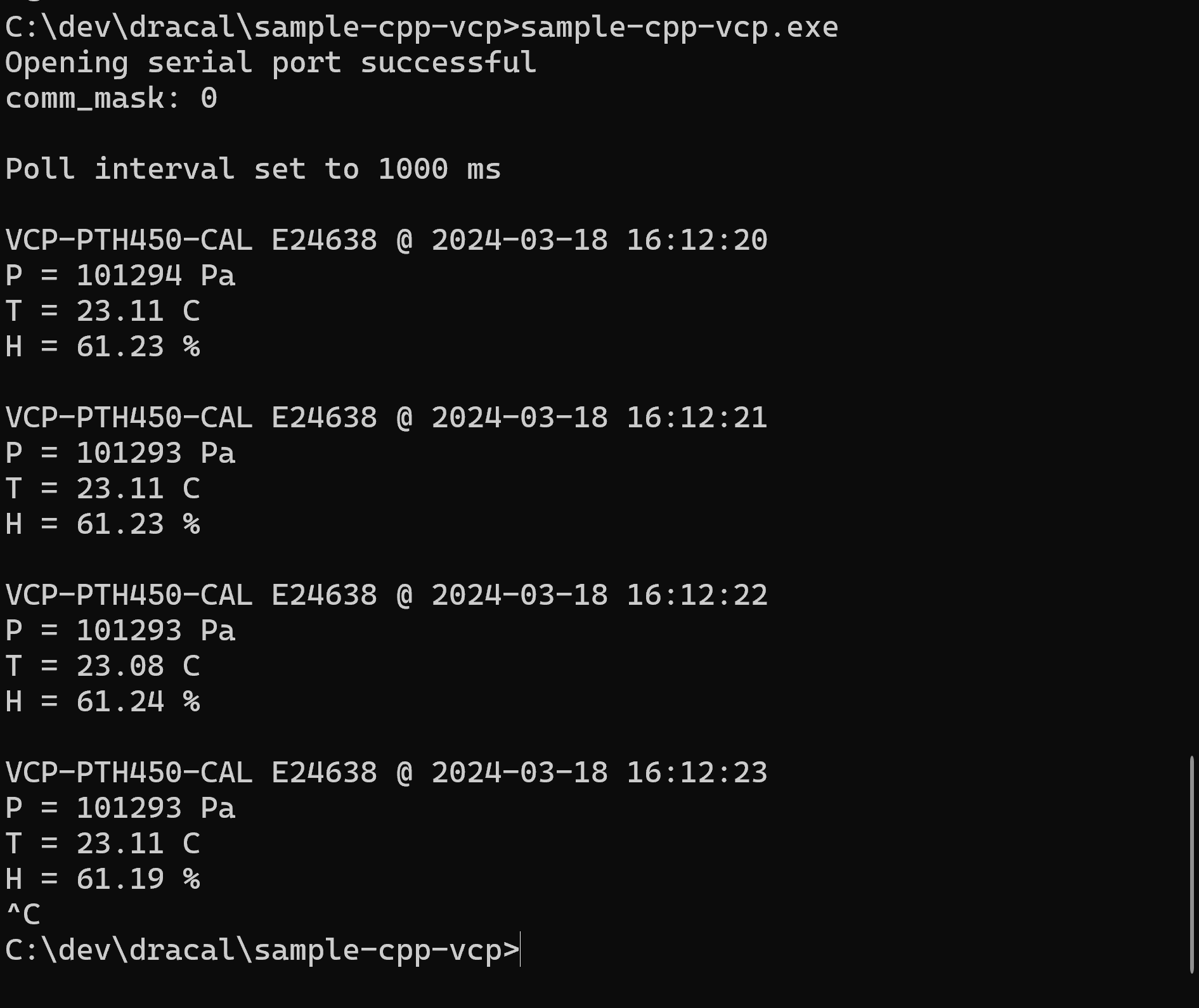
 2.4. Node.js
2.4. Node.js
Dépôt GitHub contenant un exemple de code Node.js prêt à l'emploi
L'exemple Node.js ci-dessous a été produit en utilisant un capteur VCP-PTH450-CAL, mais devrait pouvoir s'adapter à d'autres capteurs - de manière similaire à l'exemple en Python. Il ouvre séquentiellement la connexion série, envoie des instructions d'écriture pertinentes et interprète la sortie résultante. Nous ajoutons des horodatages devant chaque ligne de données, et une validation de l'intégrité des données est également effectuée. Les bibliothèques JS utilisées (toutes deux faisant partie de l'écosystème Node SerialPort disponible sur le gestionnaire de paquets NPM) sont :
- serialport
- @serialport/parser-readline
// if not using Babel, you'll want to replace `import` statements with ES5 format, e.g. `const { SerialPort } = require('SerialPort')...`
import { SerialPort } from 'serialport';
import { ReadlineParser } from '@serialport/parser-readline';
// windows: e.g. path = 'COM3';
const [path, interval, baudRate ] = ['/dev/ttyACM0', 1000, 9600];
const delay = ms => new Promise(resolve => setTimeout(resolve, ms))
// open port
const port = new SerialPort({
path,
baudRate,
});
const parser = port.pipe(new ReadlineParser({ delimiter: '\n' }));
// write instructions
port.write(Buffer.from('INFO\r\n'), err => { if (err) console.log('ERROR!', err) });
port.drain(err => { delay(100) });
port.write(Buffer.from(`POLL 1000\r\n`), err => { if (err) console.log('ERROR!', err) });
port.drain(err => { delay(100) });
port.write(Buffer.from('FRAC 2\r\n'), err => { if (err) console.log('ERROR!', err) });
port.drain(err => { delay(100) });
// read event
let info_line, padlen;
parser.on('data', async (data) => {
const split = data.replace(', ', ',').split(',');
// example info line:
// I,Product ID,Serial Number,Message,MS5611 Pressure,Pa,SHT31 Temperature,C,SHT31 Relative Humidity,%,*bbdd
// extract info line
if (split[0] === 'I') {
// parse field titles
if (split[1] == "Product ID") {
info_line = split
padlen = Math.max(...(split.slice(4).map(s => s.length)));
console.info(info_line.join(','))
// echo any other info lines
} else {
console.info(split[3]);
}
return;
}
if (!info_line) return console.info('Awaiting info line...');
// example readout line:
// D,VCP-PTH450-CAL,E24638,,102466,Pa,24.87,C,66.81,%,*d16d
// extract readout values
const device = `${split[1]} ${split[2]}`
const sensors = info_line.slice(4).filter((v, i) => i % 2 < 1);
const values = split.slice(4).filter((v, i) => i % 2 < 1).map(parseFloat);
const units = split.slice(4).filter((v, i) => i % 2 > 0);
// print result
console.info(`${new Date().toLocaleString('en-CA')} ${device}`)
for (const i in units) { // `units` will have the shorter range (no *abcd value)
console.info(`${sensors[i].padEnd(padlen + 2)} ${values[i]} ${units[i]}`)
}
console.info('\n');
});
générant la sortie suivante:
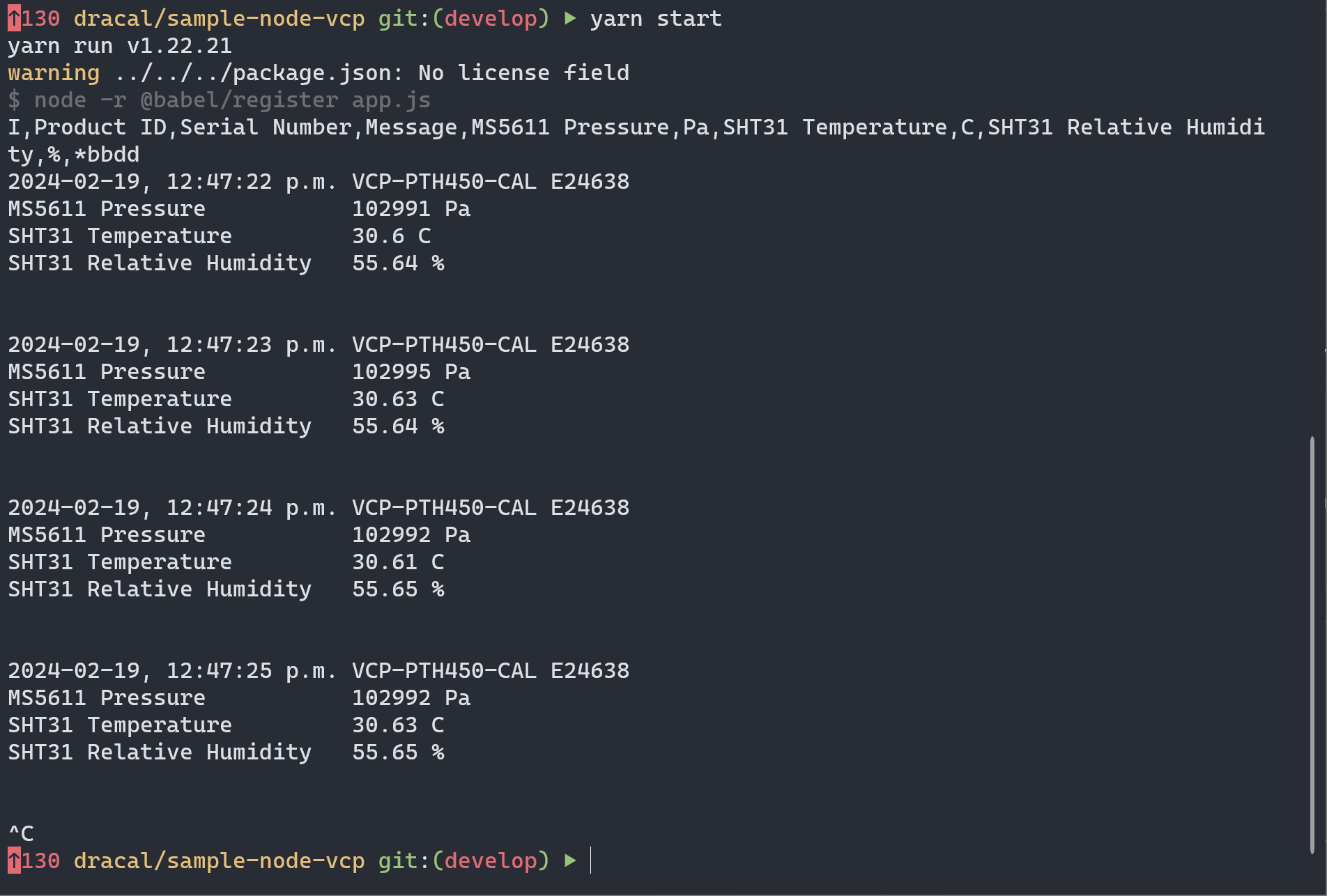
 2.5. Bash
2.5. Bash
Dépôt GitHub contenant un exemple de code Bash prêt à l'emploi
L'exemple Bash ci-dessous a été réalisé avec un capteur VCP-PTH450-CAL, mais devrait pouvoir s'adapter à d'autres capteurs - de la même manière que les exemples Python et Node. Il ouvre séquentiellement la connexion série, envoie les instructions d'écriture appropriées et interprète les résultats obtenus. Nous ajoutons des horodatages devant chaque ligne de données, et une validation simple des données est également effectuée. Il utilise quelques concepts de scripts shell, notamment
- les descripteurs de fichiers
- IFS et tableaux
#!/bin/bash
# read exec parameters
if [ "$#" -lt 1 ] || [ "$#" -gt 2 ]; then
echo "Syntax: $0 [poll_interval_ms]"
echo "Example (Linux/MacOS): $0 /dev/ttyACM0 1000"
exit 1
fi
port=$1
interval=${2:-1000} # default interval is 1000 if not provided
# open serial port for read/write (using file descriptor 3)
exec 3<>"$port"
stty -F "$port" -icrnl -onlcr
# set poll interval (allow 100 ms for request to complete)
echo -e "POLL $interval" > "$port"
sleep 0.3
# two digits past the decimal
echo -e "FRAC 2" > "$port"
sleep 0.3
# get the info line
echo -e "INFO" > "$port"
sleep 0.3
# handle incoming data
process_data() {
while IFS= read -r -u 3 line; do
t=$(date +"%Y-%m-%d %H:%M:%S")
if [ -z "$line" ]; then
break
fi
# example info line:
# I,Product ID,Serial Number,Message,MS5611 Pressure,Pa,SHT31 Temperature,C,SHT31 Relative Humidity,%,*bbdd
# clean out & split data line to array
data=$(echo "$line" | cut -d'*' -f1)
data=($data)
olfIFS="$IFS"; IFS=',' read -r -a data <<< "${data[@]}"; IFS="$oldIFS"
# extract info line
if [ "${data[0]}" == "I" ]; then
# parse field titles
if [ "${data[1]}" == "Product ID" ]; then
info_line=("${data[@]}")
padlen=$(printf "%s\n" "${info_line[@]:4}" | awk '{ print length }' | sort -n | tail -n1)
printf "%s," "${info_line[@]}"
echo ""
# echo any other info lines
else
echo "${data[@]:3}"
fi
continue;
fi
if [ -z "$info_line" ]; then echo 'Awaiting info line...'; continue; fi
# example readout line:
# D,VCP-PTH450-CAL,E24638,,102466,Pa,24.87,C,66.81,%,*d16d
# extract device ID
device="${data[1]} ${data[2]}"
# extract readout values
for i in $(seq 4 2 $(echo $data | wc -w)); do
if [[ ! $(echo $data | awk "{print \$$i}") =~ ^[0-9]+$ ]]; then
data[$i]=$(echo $data | awk "{print \$$i}" | tr -d ',')
else
data[$i]=$(echo $data | awk "{print \$$i}")
fi
done
# print it out
echo -e "\n$t, $device"
for ((i=4; i<${#data[@]}; i+=2)); do
printf "%-${padlen}s %s %s\n" "${info_line[i]}" "${data[i]}" "${data[i+1]}"
done
done
}
# run process_data in the background
process_data &
# Wait for background process to finish
wait
exec 3<&-
générant la sortie suivante: 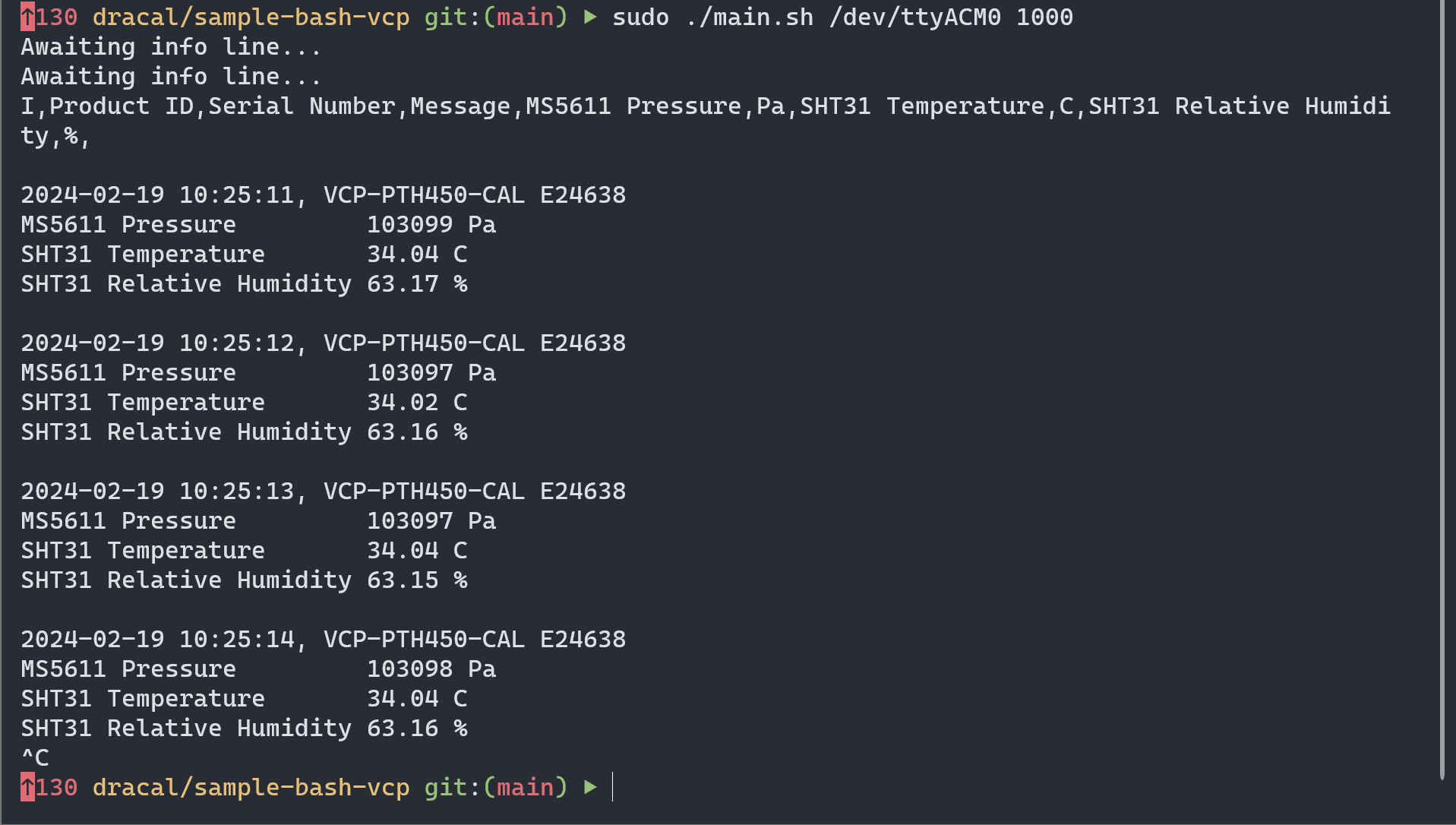
 2.6. Java
2.6. Java
Dépôt GitHub contenant un exemple de code Java prêt à l'emploi
L'exemple Java ci-dessous a été réalisé avec un capteur VCP-PTH450-CAL, mais il devrait pouvoir s'adapter à d'autres capteurs - de la même manière que les exemples Python et Node. Il ouvre séquentiellement la connexion série, envoie les instructions d'écriture appropriées et interprète les résultats obtenus. En lecture, les sauts de ligne (\r\n) sont traités manuellement. Nous ajoutons des horodatages devant chaque ligne de données, et une validation de base des données est également effectuée. La bibliothèque java-native:jssc est utilisée pour lire les ports série.
package src.main.java;
import java.time.LocalDateTime;
import java.time.format.DateTimeFormatter;
import java.util.Arrays;
import java.util.List;
import jssc.SerialPort;
import jssc.SerialPortEvent;
import jssc.SerialPortEventListener;
import jssc.SerialPortException;
public class Main {
// replace with appropriate path, interval, and baudRate
static String path = "/dev/ttyACM0";
static int interval = 1000;
static int baudRate = 9600;
// working globals
static String[] info_line;
static int padlen;
public static void main(String[] args) {
// open port
SerialPort serialPort = new SerialPort(path);
try {
serialPort.openPort();
serialPort.setParams(baudRate, SerialPort.DATABITS_8, SerialPort.STOPBITS_1, SerialPort.PARITY_NONE);
} catch (SerialPortException ex) {
System.out.println("Error setting up serial port: " + ex);
}
// write instructions
try {
serialPort.writeBytes("INFO\r\n".getBytes());
Thread.sleep(1000);
serialPort.writeBytes("POLL 1000\r\n".getBytes());
Thread.sleep(1000);
serialPort.writeBytes("FRAC 2\r\n".getBytes());
Thread.sleep(1000);
} catch (SerialPortException | InterruptedException ex) {
System.out.println("Error writing to serial port: " + ex);
}
// read event
try {
serialPort.addEventListener(new SerialPortEventListener() {
StringBuilder line = new StringBuilder();
@Override
public void serialEvent(SerialPortEvent event) {
if (event.isRXCHAR()) {
try {
// accumulate reads until the end of line
byte[] buffer = serialPort.readBytes();
for (byte currentByte: buffer) {
if ( (currentByte == '\r' || currentByte == '\n') && line.length() > 0) {
// send for processing
processData(line.toString());
line.setLength(0);
}
else {
line.append((char) currentByte);
}
}
} catch (SerialPortException ex) {
System.out.println("Error reading from serial port: " + ex);
}
}
}
});
} catch (SerialPortException ex) {
System.out.println("Error setting up event listener: " + ex);
}
}
// parse a data line and display results
private static void processData(String data) {
String[] split = data.replace(", ", ",").split("\\*")[0].split(",");
// extract info line
if (split[0].contains("I")) {
// parse field titles
if (split[1].equals("Product ID")) {
info_line = split;
List values = Arrays.asList(Arrays.copyOfRange(split, 4, split.length));
padlen = values.stream().map(String::length).max(Integer::compareTo).get();
System.out.println(Arrays.toString(info_line));
} else {
System.out.println(split[3]);
}
return;
}
if (info_line == null) {
System.out.println("Awaiting info line...");
return;
}
// parse readout values
String device = split[1] + " " + split[2];
String[] sensors = new String[(info_line.length - 4) / 2];
double[] values = new double[sensors.length];
String[] units = new String[sensors.length];
String[] info = Arrays.copyOfRange(info_line, 4, info_line.length);
for (int i = 0; i < info.length - 1; i += 2) {
sensors[i/2] = info[i].trim();
values[i/2] = Double.parseDouble(split[i + 4]);
units[i/2] = split[i + 5].trim();
}
// print result
String now = DateTimeFormatter.ofPattern("yyyy/MM/dd HH:mm:ss").format(LocalDateTime.now());
System.out.println(now + " " + device);
for (int i = 0; i < units.length; i++) {
System.out.println(String.format("%-" + (padlen + 2) + "s %s %s", sensors[i], values[i], units[i]));
}
System.out.println("\n");
}
}
générant la sortie suivante:
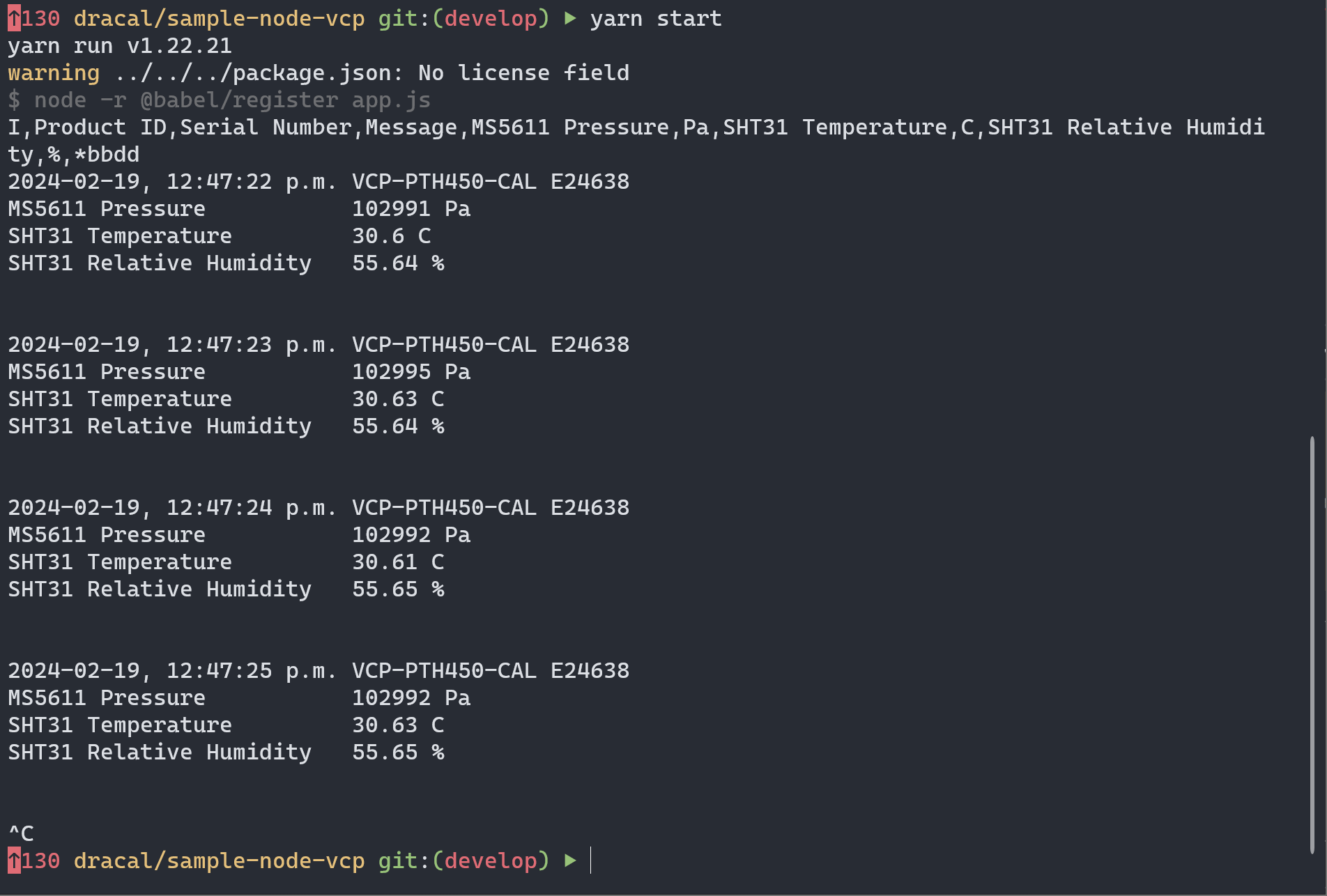
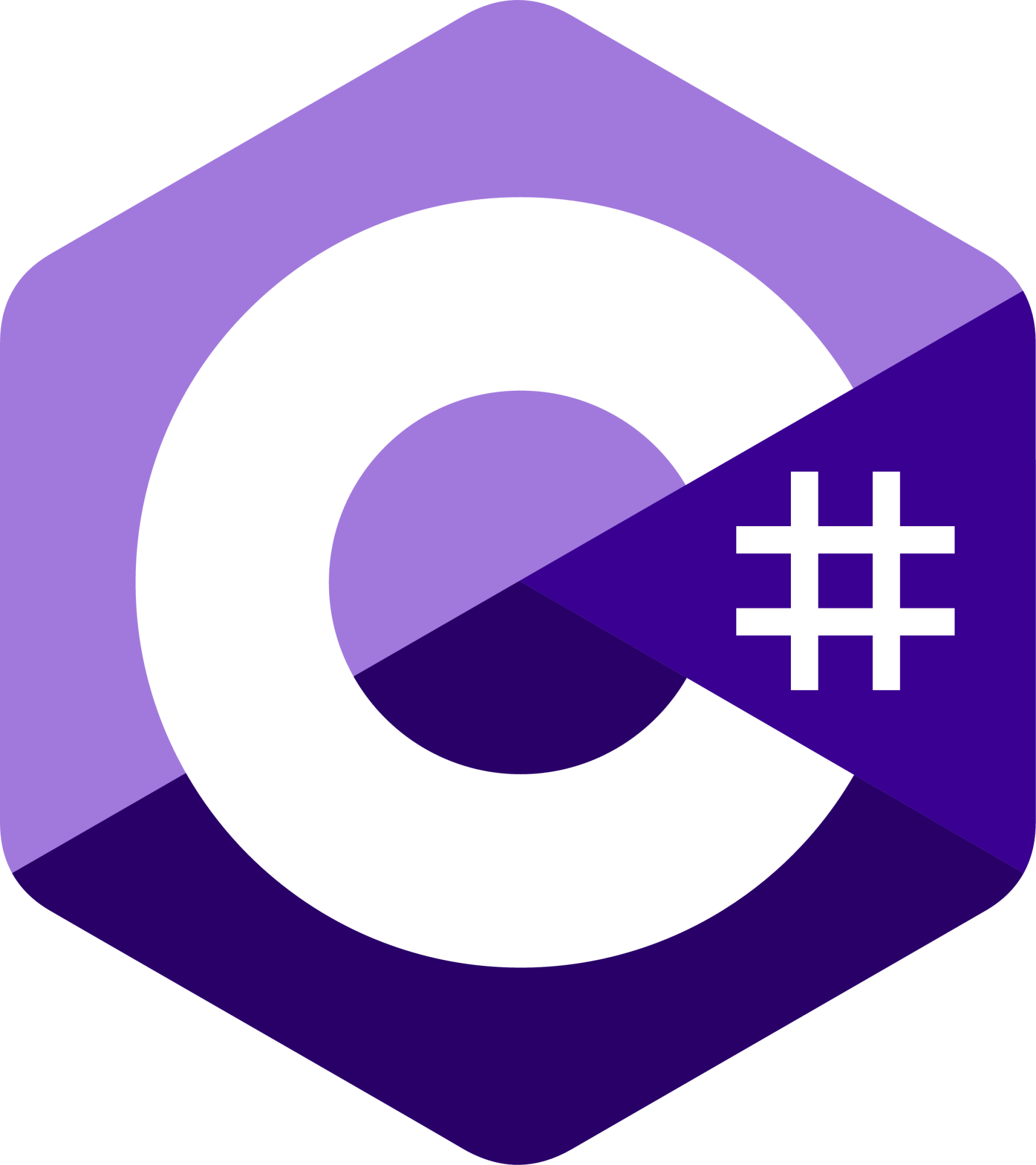 2.7. C#
2.7. C#
Dépôt GitHub contenant un exemple de code Java prêt à l'emploi
L'exemple C# ci-dessous a été réalisé à l'aide d'un capteur VCP-PTH450-CAL ; il devrait pouvoir s'adapter à d'autres capteurs - de la même manière que les exemples Python et Node.
Il ouvre séquentiellement la connexion série, envoie les instructions d'écriture appropriées et interprète la sortie résultante par le biais d'une boucle liée à l'état. Lors de la lecture, les sauts de ligne sont traités automatiquement par Readline(). Nous ajoutons des horodatages devant chaque ligne de données, et une validation de base des données est également effectuée.
Notez que l'approche standard de la lecture avec SerialPort serait d'utiliser un gestionnaire d'événement ajouté à `port.DataReceived`. Malheureusement, cela ne semble lire que les réactions d'entrée, mais pas les sorties ultérieures/régulières du périphérique. C'est pourquoi l'option loop est choisie ici. Vous êtes bien sûr invités à ouvrir un Pull Request si vous souhaitez proposer d'autres solutions à ce problème.
System.IO.Ports.SerialPort est utilisé pour lire le périphérique.
using System.IO.Ports;
class App
{
const string PATH = "COM4";
const int BAUDRATE = 9600;
const int INTERVAL = 1000;
static SerialPort port = new(PATH, BAUDRATE, Parity.None, 8, StopBits.One);
static string[]? info_line;
static int padlen;
static void Main(string[] args)
{
Console.CancelKeyPress += (s, e) => { Environment.Exit(0); };
try
{
port.Open();
port.Write($"POLL {INTERVAL}\r\n");
Task.Delay(100).Wait();
port.Write("FRAC 2\r\n");
Task.Delay(100).Wait();
port.Write("INFO\r\n");
Task.Delay(100).Wait();
// NOTE: while the standard approach would be to use Event handler `port.DataReceived`, it has
// proven unable to receive non-input driven readout data thus far.
while (port.IsOpen)
{
handleReceivedData();
}
}
catch (Exception e)
{
Console.WriteLine(e.ToString());
}
}
static void handleReceivedData()
{
string data = port.ReadLine();
string[] split = data.Replace(", ", ",").Split('*')[0].Split(',');
if (split[0] == "I")
{
if (split[1] == "Product ID")
{
info_line = split;
padlen = split.Skip(4).OrderByDescending(s => s.Length).First().Length;
Console.WriteLine(string.Join(",", split));
}
else
{
Console.WriteLine(split[3]);
}
return;
}
if (info_line == null)
{
Console.WriteLine("Awaiting info line...");
return;
}
string device = $"{split[1]} {split[2]}";
string[] sensors = info_line[4..].Where((v, i) => i % 2 < 1).ToArray();
string[] values = split[4..].Where((v, i) => i % 2 < 1)/*.Select(double.Parse)*/.ToArray();
string[] units = split[4..].Where((v, i) => i % 2 > 0).ToArray();
Console.WriteLine($"{DateTime.Now.ToString("yyyy-MM-dd HH:mm:ss")} {device}");
for (int i = 0; i < units.Length; i++)
{
Console.WriteLine($"{sensors[i].PadRight(padlen + 2)} {values[i]} {units[i]}");
}
Console.WriteLine("\n");
}
}
générant la sortie suivante:
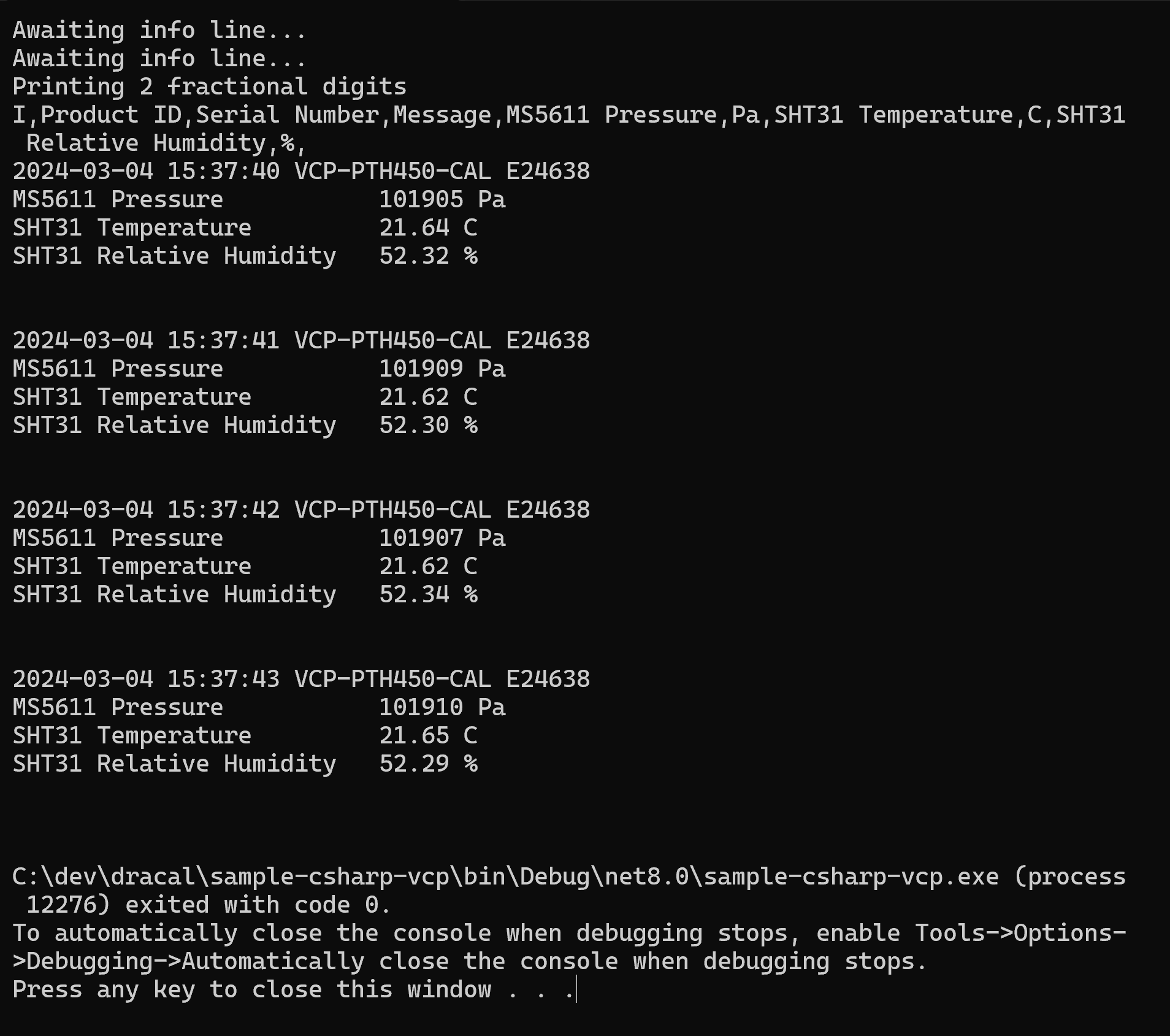
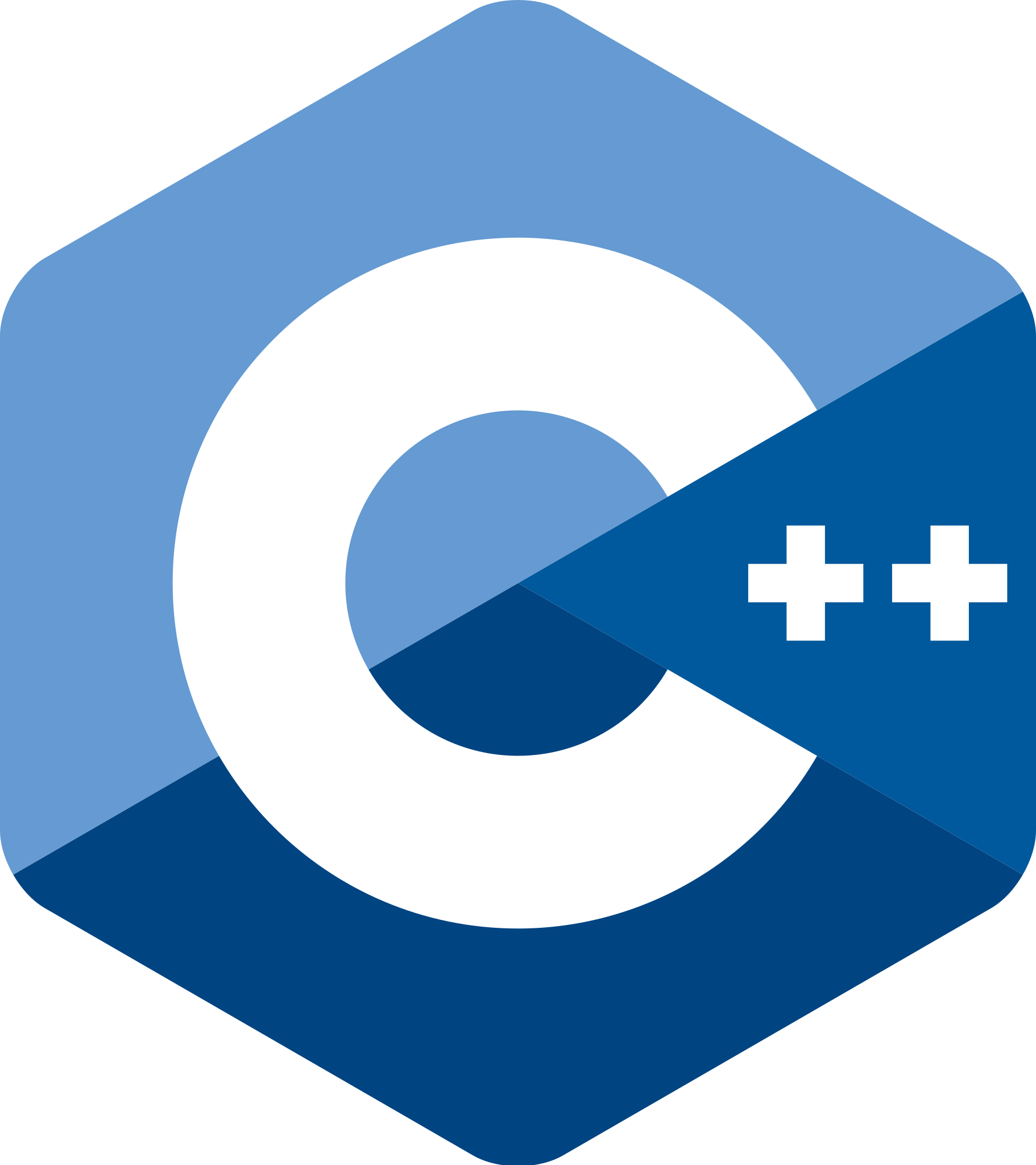 2.8. C++/CLI (.NET)
2.8. C++/CLI (.NET)
Dépôt GitHub contenant un exemple de code C++ (.NET) prêt à l'emploi
L'exemple C++/CLI (.NET) ci-dessous a été réalisé avec un capteur VCP-PTH450-CAL ; il devrait pouvoir s'adapter à d'autres capteurs - de la même manière que les exemples Python et Node.
Il ouvre séquentiellement la connexion série, envoie les instructions d'écriture appropriées et interprète la sortie résultante par le biais d'une boucle liée à l'état. Lors de la lecture, les sauts de ligne sont traités automatiquement par Readline(). Nous ajoutons des horodatages devant chaque ligne de données, et une validation de base des données est également effectuée. Notez que - comme en C# - l'approche standard de la lecture avec SerialPort serait d'utiliser un gestionnaire d'événement ajouté à `port->DataReceived`. Malheureusement, cela ne semble que lire les réactions d'entrée, mais pas les sorties ultérieures/régulières de l'instrument. C'est pourquoi l'option de la boucle est choisie ici.
System::IO::Ports::SerialPort est utilisé pour lire le périphérique.
#include <msclr/gcroot.h>
#using <System.dll>
using namespace msclr;
using namespace System;
using namespace System::IO::Ports;
using namespace System::Threading;
const auto PATH = "COM3";
const int BAUDRATE = 9600;
const int INTERVAL = 1000;
// allow ref type static storage w/ gcroot()
gcroot<array<String^>^> info_line;
int padlen = 0;
int GetMaxLength(array<String^>^ split)
{
int maxLength = 0;
for each (auto str in split) {
maxLength = std::max(str->Length, maxLength);
}
return maxLength;
}
void handleReceivedData(SerialPort^ port)
{
String^ data = port->ReadLine();
array<String^>^ split = data->Split(',');
if (split[0] == "I")
{
if (split[1] == "Product ID")
{
info_line = split;
padlen = GetMaxLength(split);
Console::WriteLine(String::Join(",", info_line));
}
else
{
Console::WriteLine(split[3]);
}
return;
}
if (info_line == nullptr || info_line->Length < 1)
{
Console::WriteLine("Awaiting info line...");
return;
}
String^ device = String::Format("{0} {1}", split[1], split[2]);
array<String^>^ sensors = gcnew array<String^>((info_line->Length - 4) / 2);
array<Double^>^ values = gcnew array<Double^>(sensors->Length);
array<String^>^ units = gcnew array<String^>(sensors->Length);
// map value positions into dedicated arrays
for (int i = 0; i < info_line->Length - 5; i += 2) {
sensors[i / 2] = info_line[i + 4]->Trim();
values[i / 2] = Double::Parse(split[i + 4]);
units[i / 2] = split[i + 5]->Trim();
}
// display results
Console::WriteLine(String::Format("\n{0} {1} {2}", DateTime::Now.ToShortDateString(), DateTime::Now.ToShortTimeString(), device));
for (int i = 0; i < units->Length; i++)
{
Console::WriteLine(String::Format("{0} {1} {2}", sensors[i]->PadRight(padlen + 2, ' '), values[i], units[i]));
}
}
void Console_CancelKeyPress(Object^ sender, ConsoleCancelEventArgs^ e)
{
Environment::Exit(0);
}
int main(array<String^>^ args)
{
Console::CancelKeyPress += gcnew ConsoleCancelEventHandler(Console_CancelKeyPress);
String^ path = gcnew String(PATH);
SerialPort^ port = gcnew SerialPort(path, BAUDRATE, Parity::None, 8, StopBits::One);
try
{
port->Open();
port->WriteLine("POLL " + INTERVAL);
Thread::Sleep(100);
port->WriteLine("FRAC 2");
Thread::Sleep(100);
port->WriteLine("INFO");
Thread::Sleep(100);
// NOTE: while the standard approach would be to use Event handler `port.DataReceived`, it has
// proven unable to receive non-input driven readout data thus far.
while (port->IsOpen)
{
handleReceivedData(port);
}
}
catch (Exception^ e)
{
Console::WriteLine(e->ToString());
}
}
produisant la sortie suivante: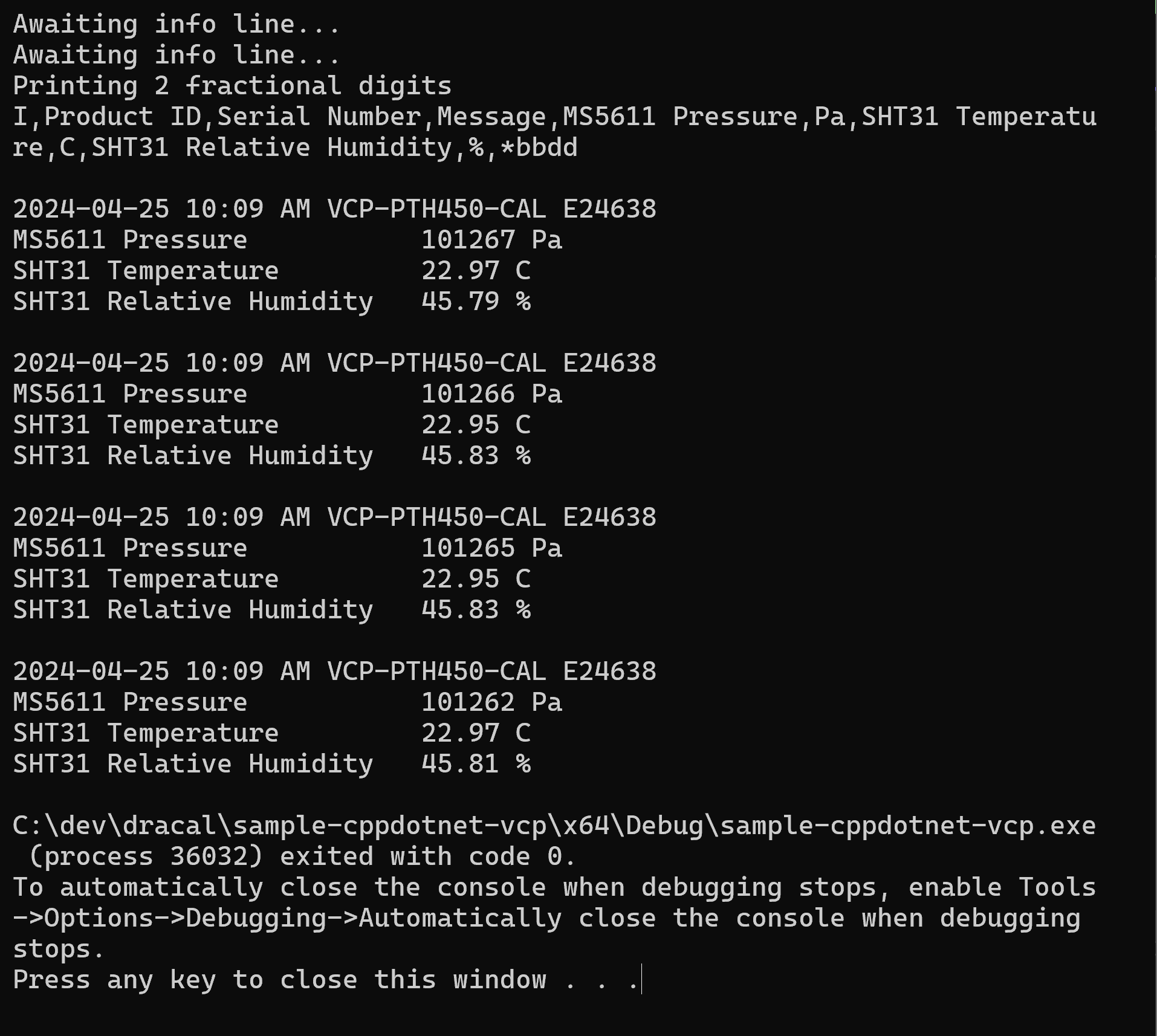
 2.9. VB.Net
2.9. VB.Net
Dépôt GitHub contenant un exemple de code VB.Net prêt à l'emploi
L'exemple VB.Net ci-dessous a été réalisé à l'aide d'un capteur VCP-PTH450-CAL ; il devrait pouvoir s'adapter à d'autres capteurs - de la même manière que les exemples C#, Python et Node.
Il ouvre séquentiellement la connexion série, envoie les instructions d'écriture appropriées et interprète la sortie résultante par le biais d'une boucle liée à l'état. Lors de la lecture, les sauts de ligne sont traités automatiquement par Readline(). Nous ajoutons des horodatages devant chaque ligne de données, et une validation de base des données est également effectuée.
Notez que - comme en C# - l'approche standard de la lecture avec SerialPort serait d'utiliser un gestionnaire d'événement ajouté à port->DataReceived. Malheureusement, cela ne semble que lire les réactions d'entrée, mais pas les sorties ultérieures/régulières de l'appareil. C'est pourquoi l'option de la boucle est choisie ici.
System.IO.Ports.SerialPort est utilisé pour lire le périphérique.
Imports System.IO.Ports
Module App
Const PATH As String = "COM3"
Const BAUDRATE As Integer = 9600
Const INTERVAL As Integer = 1000
Dim port As SerialPort = New SerialPort(PATH, BAUDRATE, Parity.None, 8, StopBits.One)
Dim info_line As String() = Nothing
Dim padlen As Integer = 0
Sub Main(args As String())
AddHandler Console.CancelKeyPress, Sub(s, e)
port.Close()
Environment.Exit(0)
End Sub
Try
port.Open()
port.Write($"POLL {INTERVAL}" & vbCrLf)
Task.Delay(100).Wait()
port.Write("FRAC 2" & vbCrLf)
Task.Delay(100).Wait()
port.Write("INFO" & vbCrLf)
Task.Delay(100).Wait()
' NOTE: while the standard approach would be to use Event handler `port.DataReceived`, it has
' proven unable to receive non-input driven readout data thus far.
While port.IsOpen
handleReceivedData()
End While
Catch e As Exception
Console.WriteLine(e.ToString())
End Try
End Sub
Sub handleReceivedData()
Dim data As String = port.ReadLine()
Dim split As String() = data.Replace(", ", ",").Split("*"c)(0).Split(","c)
If split(0) = "I" Then
If split(1) = "Product ID" Then
info_line = split
padlen = split.Skip(4).OrderByDescending(Function(s) s.Length).First().Length
Console.WriteLine(String.Join(",", split))
Else
Console.WriteLine(split(3))
End If
Return
End If
If info_line Is Nothing Then
Console.WriteLine("Awaiting info line...")
Return
End If
Dim device As String = $"{vbCrLf}{vbCrLf}{split(1)} {split(2)}"
Dim sensors As String() = info_line.Skip(4).Where(Function(v, i) (i Mod 2 < 1)).ToArray()
Dim values As String() = split.Skip(4).Where(Function(v, i) (i Mod 2 < 1)).ToArray()
Dim units As String() = split.Skip(4).Where(Function(v, i) (i Mod 2 > 0)).ToArray()
Console.WriteLine($"{DateTime.Now.ToString("yyyy-MM-dd HH:mm:ss")} {device}")
For i As Integer = 0 To units.Length - 1
Console.WriteLine($"{sensors(i).PadRight(padlen + 2)} {values(i)} {units(i)}")
Next
End Sub
End Module
produisant la sortie suivante: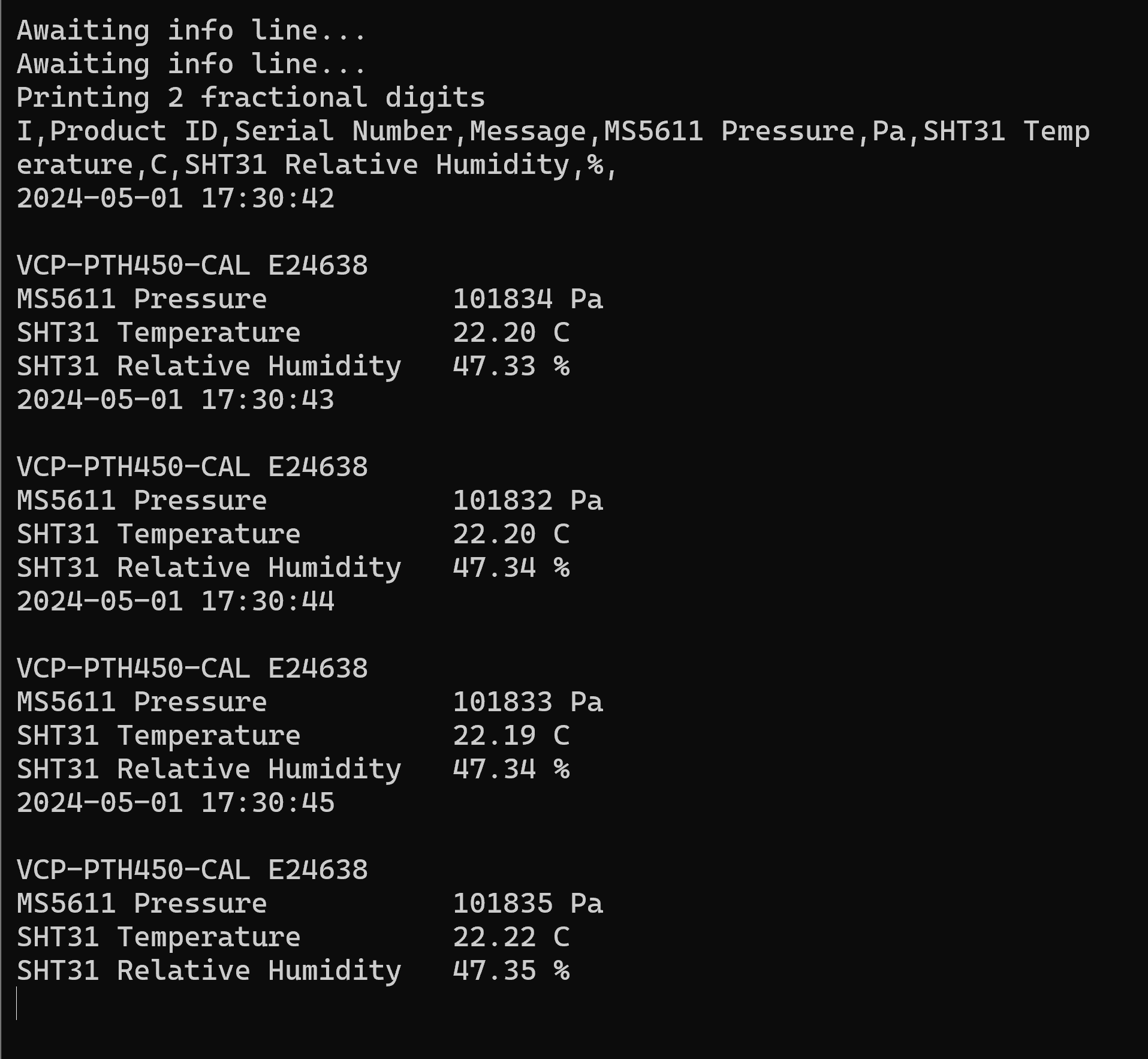
3. License et avis de non-responsabilité
Sauf indication contraire, les extraits de code sur cette page sont placés dans le domaine public et peuvent être incorporés dans tout logiciel, commercial ou non. Les exemples sur cette page sont fournis "en l'état", dans l'espoir qu'ils puissent servir, mais sans AUCUNE GARANTIE de quelque nature que ce soit, expresse ou implicite, y compris, mais sans y être limité, les garanties implicites de commerciabilité et de la conformité à une utilisation particulière. Les pratiques recommandées de programmation, telles que la gestion et détection d'erreurs, la validation des entrées et les tests, sont sous la responsabilité de l'utilisateur, qui assume également la totalité des risques liés à la qualité et aux performances du code. Dracal Technologies Inc. n'accepte aucune responsabilité quant à l'exactitude, l'intégralité, la performance ou la fiabilité du code sur cette page. Dracal Technologies Inc. ne pourrait être tenue responsable à votre égard des dommages, incluant les dommages génériques, spécifiques, secondaires ou consécutifs, résultant de l'utilisation ou de l'incapacité d'utiliser le code (y compris, mais sans y être limité, la perte de données, ou le fait que des données soient rendues imprécises, ou les pertes éprouvées par vous ou par des tiers).